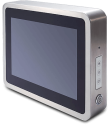
ADLINK has introduced standalone data acquisition modules MCM-216 and MCM-218, which are based on the ARM Cortex-A9 processor and have 16 or 8 channels for measuring current and voltage. Thanks to the powerful processor, the MCM-216 and MCM-218 modules can operate without an external PC, measure various IIoT installations, and optimize data for sending to the upper level.
Typically, remote input modules simply convert analog values from sensors to digital values and then wait for a request from a PC that is already processing these digital signals. The MCM-216 and MCM-218 stand-alone data acquisition modules allow for on-site filtering and conversion of raw sensor signals into useful data, which reduces the amount of data to be transmitted over the network and significantly reduces both network load and PC computing resource requirements.
The modules support the creation of custom data processing algorithms that can be created in C/C++ and then loaded via the web console. You can receive data from modules via Modbus TCP, RESTful API, Streaming SDK or TCP Socket in Client mode.
The MCM-216 module has 16/8 channels for voltage measurement, and the MCM-218 module has 8 channels for current measurement. Both modules can poll channels at up to 250k samples per second in multiplexing mode. Also, the modules have 2 analog outputs and 4 channels of discrete input and output.
The modules have 2 gigabit Ethernet ports that operate as an unmanaged switch and allow modules to be connected in a daisy chain, which saves the budget and eliminates the need to install an additional switch. In addition, the modules support the installation of a Wi-Fi adapter for wireless data transfer, which in some cases is much more convenient than pulling wires.
Key features of the new MCM-216 and MCM-218 modules:
| Name | MCM-216 | MCM-218 |
|---|---|---|
| Gigabit Ethernet | 2x RJ45 ports, 1 IP | |
| CPU | ARM Cortex A9, 1.0 GHz | |
| NAND Flash | 4 GB eMMC | |
| RAM | 1 GB DDR3 RAM | |
| USB | 2x USB 2.0 only for Wi-Fi module and USB drive | |
| Power requirements | 9 to 30 VDC | |
| Power consumption | 8.8 W max | |
| Isolation | 1.5 KV | |
| Communication interfaces | Modbus TCP, RESTful API, Streaming SDK, TCP Socket в режиме Client | |
| Digital temperature sensor | -50°C to 150°C, 3 meters cable | |
| Analog input | ||
| Resolution | 16 bit | |
| Channels | 16 SE / 8 differential voltage inputs | 8 current inputs |
| Samples per second | 250 ksample per second, Multiplexing | |
| Input range | +/-10 V, +/-2.5 V, +/-1.25 V, +/-312.5 mV | 0-20 mA |
| Offset error | ± 0.1 mV (± 10 V) | ±0.01 mA |
| Gain error | ± 0.05% of FSR range (± 10V) | ±0.05% of FSR range |
| Analog output | ||
| Resolution | 16 bit | |
| Channels | 2 outputs, voltage and current | |
| Samples per second | 100k samples per second | |
| Input range | ±10V, 0-20mA | |
| Discrete I/O | ||
| Channels | 4 DI and 4 DO | |
| Channel type | TTL input: 0-5V for DI, open drain for DO | |
| Input logic level values |
Logic 0: VIL = 0.8 V, IIL = 0.2 mA Logic 1: VIH = 2.0 V, IIH = 0.2 mA |
|
| Surge protection | ± 50 V | |
| Other characteristics | ||
| Dimensions | 110.5 x 40 x 126.5 mm | |
| Connectors | Terminal block | |
| Chassis design | Metall, IP30 | |
| Mounting | DIN rail, optional wallmount | |
| Operational temperature | 0…70°C | |

